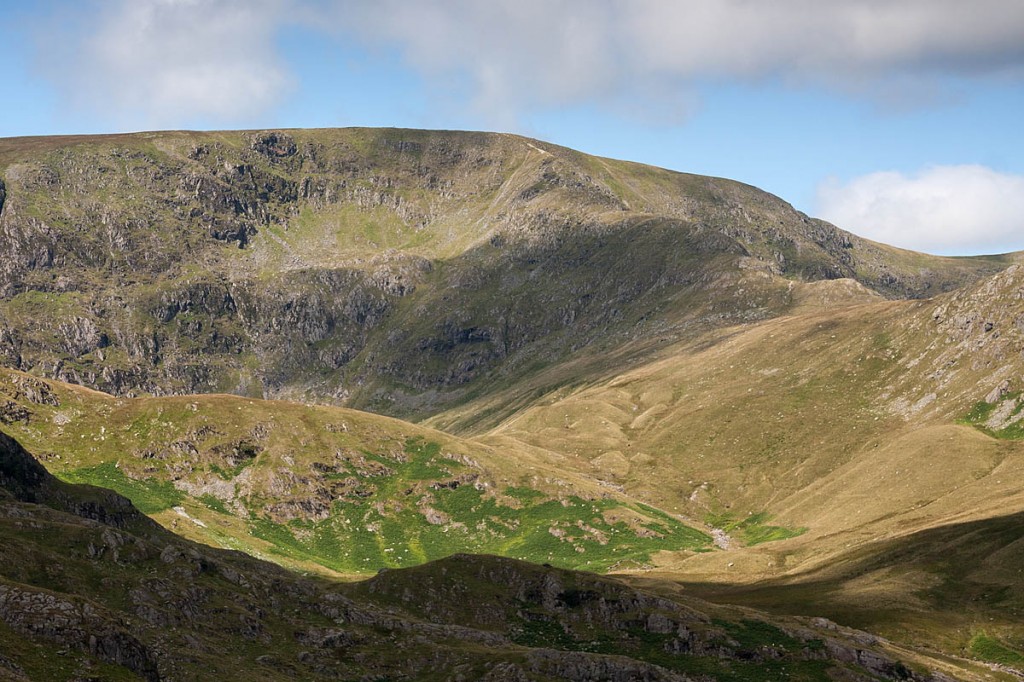Aficionados of the late fellwalking author Alfred Wainwright will fund repairs to a Lakeland path he called a connoisseur’s route.
The Wainwright Society has chosen Fix the Fells as its main beneficiary of fundraising next year.
Cash from the society’s charity events will go to the organisation to repair and maintain the path on Long Stile, below the High Street plateau.
The Wainwright Society said the scree ascent of Long Stile has suffered much erosion in recent years and is now in need of a stone-pitched path to stop it getting worse.
The land on either side of the path also needs to be repaired and protected from further damage. This will require stone to be brought in by helicopter, which will add to the cost of the repair. The work is scheduled to be undertaken during 2018.
The path lies on the upper reaches of the ridge leading from the head of Haweswater in Mardale to High Street, via Swine Crag, Heron Crag, Eagle Crag, Rough Crag and Riggindale Crag, which was once home to the Lake District’s only pair of golden eagles.
Writing in a volume of his Pictorial Guides to the Lakeland Fells, Wainwright said of the route: “The ridge of Rough Crag and the rocky stairway of Long Stile together form the connoisseur’s route up High Street, the only route that discloses the finer characteristics of the fell.
“The ascent is a classic, leading directly along the crest of a long, straight ridge that permits of no variation from the valley to the summit. The views are excellent throughout.”
Joanne Backshall, Fix the Fells programme manager, said: “We are delighted that the Wainwright Society is being so generous and supporting our vital work to protect some of the most beautiful parts of the Lake District.
“It will allow us to repair a popular route that was loved by Alfred Wainwright and mean that generations to come can enjoy it as well.”
Fix the Fells undertakes the repair of eroded and damaged footpaths in the Lake District. It is a partnership between the National Trust, the Lake District National Park Authority, Friends of the Lake District, Nurture Lakeland, Natural England, Cumbria County Council and volunteers.
The work is undertaken by National Trust fell rangers and Lake District National Park Authority volunteers. In the past 10 years it has repaired more than 200 sections of fell paths using a variety of traditional techniques.
It costs £150 to repair just one metre of path. At the moment Fix the Fells needs to raise £350,000 per year to carry out all of its work.
The Wainwright Society was founded in 2002 to keep alive the ideas the author promoted in his guidebooks. Over the years it has raised thousands of pounds for causes it believes he would have appreciated and supported. Money will be raised from donations by society members taking part in its annual charity challenge, along with sales of its calendar. The challenge, based in the far eastern fells, celebrates 60 years since Alfred Wainwright’s guidebook to the area was published in 1957. It hopes to raise most of the money needed to fund the expensive repair to the classic Lakeland route.


Wilf from Keswick
15 December 2016Don’t make me laugh, “using a variety of traditional techniques”. When they get it right they do a fantastic job but quite often they get it spectacularly wrong. Usually when they DO NOT use traditional techniques and definitely NOT traditional materials. These methods are short term fixes rather than long term solutions to the issue of damage and erosion. Short term = a couple of decades.
The snake path on Sail,
The path from Cat Gill and towards Bleaberry Fell,
The Langstrath side of Stake Pass,
The Troutbeck side of Garburn Pass,
The path next to Grasmere and Rydal,
Nanny Lane Troutbeck,
I could go on all day but I’m sure you get the picture.
Hopefully they do a proper job on this one. It would be a shame for them to ruin another good route.
Colin B
20 December 2016Yes, and what about the new 'ish' path running from the cattle grid below Side Pike down to Great Langdale.
It's not that old and it's already starting to erode.
Another example of not using a traditional technique and / or materials that are fit for purpose.